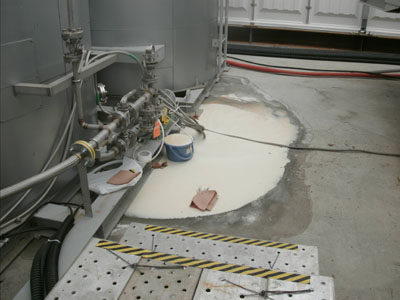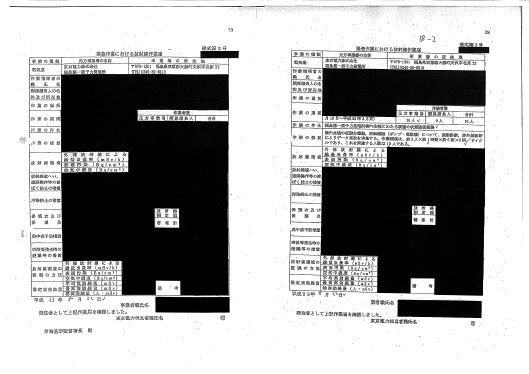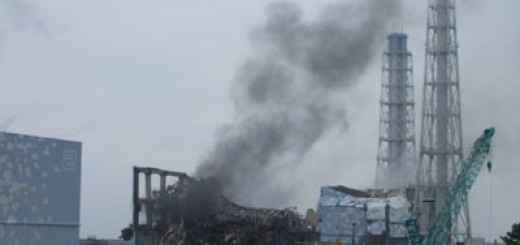Fukushima: Take measures for worker exposure Nuke Info Tokyo No. 146
 |
| Fig 1: Leaking desalination units (Photo by TEPCO) |
The Japanese government and Tokyo Electric Power Co. (TEPCO) declared on Dec. 16 that the project to bring the Fukushima Daiichi Nuclear Power Plant to a state of cold shutdown had been achieved, and that Step 2 of the road map for bringing the plant under control had been completed. It cannot be considered, however, that the future stages of the road map will be carried out smoothly and that the catastrophic accident at the plant will move towards a complete resolution.
In the plant’s No.1, No.2. and No.3 reactors, the nuclear fuel in the cores has melted down but the actual situation within the reactors is still unknown. The molten nuclear fuel is leaking from the bottom of the pressure vessel and is likely to cause vapor explosions should the reactor core undergo recriticality or the fuel comes into contact with underground water. The work to remove highly radioactive water from the reactor buildings is facing great difficulties, and contamination of underground water and seawater is spreading. Plant workers are engaged in clean-up operations in this extremely difficult situation.
On Jan. 9, 2012, TEPCO announced that a male worker from a company cooperating with TEPCO lost consciousness while working and fell into a state of cardiac and respiratory arrest. According to the plant operator, the worker in his 60’s had been engaged since the morning in work to construct a tank for holding radioactive materials accumulated in the treatment of highly contaminated water. Shortly after 2:00 p.m., the worker complained of sickness and was taken to a hospital in Iwaki, Fukushima Prefecture. He died of myocardial infarction at around 5:00 p.m. The total amount of the internal and external exposure to radiation received by the worker since May 2011 was 6.09 millisievert. Since the outbreak of the nuclear crisis in March last year, three workers have already died while engaged in the clean-up operations at the plant, this being the fourth case.
As we have reported so far, CNIC has persistently negotiated, jointly with other NGOs, with the government ministries and agencies concerned on worker exposure to radiation in the clean-up operations at the plant.
On Dec. 16, the Ministry of Health, Labor and Welfare drastically lowered the maximum permissible level of cumulative radiation exposure for workers who began working at the plant on or after Nov. 1, 2011, from 250 millisievert to 100 millisievert. (www.mhlw.go.jp/stf/houdou/2r9852000001yeem.html) Nevertheless, the ministry did not change the 250 millisievert limit for workers currently working on problems with reactor equipment and components in highly contaminated areas, and workers who are currently participating in emergency operations. The ministry also decided to apply the 250-millisievert limit to about 50 TEPCO employees with high technical expertise indispensable for maintaining the cooling system of nuclear reactors until April 30, 2012.
Even though Step 2 of the road map for bringing Fukushima Daiichi Nuclear Power Station under control has been completed, the 100-millisievert limit will be applied to workers as long as emergency operations are continuing at the plant. This indicates that reduction of the radiation exposure limit will continue to be a major problem and this is a task we must tackle. To achieve this, we must obtain from TEPCO and plant makers necessary data on the radiation doses to be absorbed by workers engaged in each type of operation, estimates of the number of workers needed for such operations, and the propriety of the estimates.
On Aug. 31, the health ministry assigned the following three tasks to TEPCO as part of its efforts to lower the 250-millisievert limit, 1) Devise new measures to protect workers from internal exposure, 2) Draw up a list of operations that require work in highly radioactive environments necessary for achieving the goals in Step 2 of the road map and devise measures to reduce worker radiation exposure, and 3) Draw up a list of locations of high radiation in the reactor buildings and other related facilities and formulate measures to reduce radiation levels in such places.
In response, TEPCO submitted three reports to the ministry during the September-October period. The reports included a list of emergency work carried out in highly irradiated areas at the Fukushima nuclear plant and measures to reduce worker exposure to radiation. We filed a request with the ministry for disclosure of the reports and obtained copies of the documents. However, large parts of the reports were not disclosed (see Fig. 2) and their contents are still unknown.
People all over the world are watching developments at the Fukushima nuclear power plant, hoping that the disastrous accident will be fundamentally and completely resolved. They are praying for the safety of the workers and monitoring the situation at the plant. In view of this situation, it is not permissible for the government and the plant operator to conceal details of the operations being carried out by the workers and measures for reducing worker radiation exposure.
In future negotiations with the government and TEPCO, we must demand that the decisions on 1) the permissible level of radiation exposure of the workers engaged in emergency operations in Step 2 and later stages, 2) the locations and other details of the work they do, and 3) measures to reduce worker radiation exposure should not be left in the hands of the plant operator alone, and the negotiating partners must fully disclose these data. To urge the utility and plant makers to thoroughly implement measures to reduce the level of worker exposure and to force down worker exposure limits to lower levels, we must press them to secure a sufficient number of workers for the work that needs to be carried out.
Mikiko Watanabe (CNIC)
 |
| Fig 2: The blacked-out reports on the Listing of operations that require work in highly radioactive environments disclosed by Ministry of Health, Labor and Welfare |


